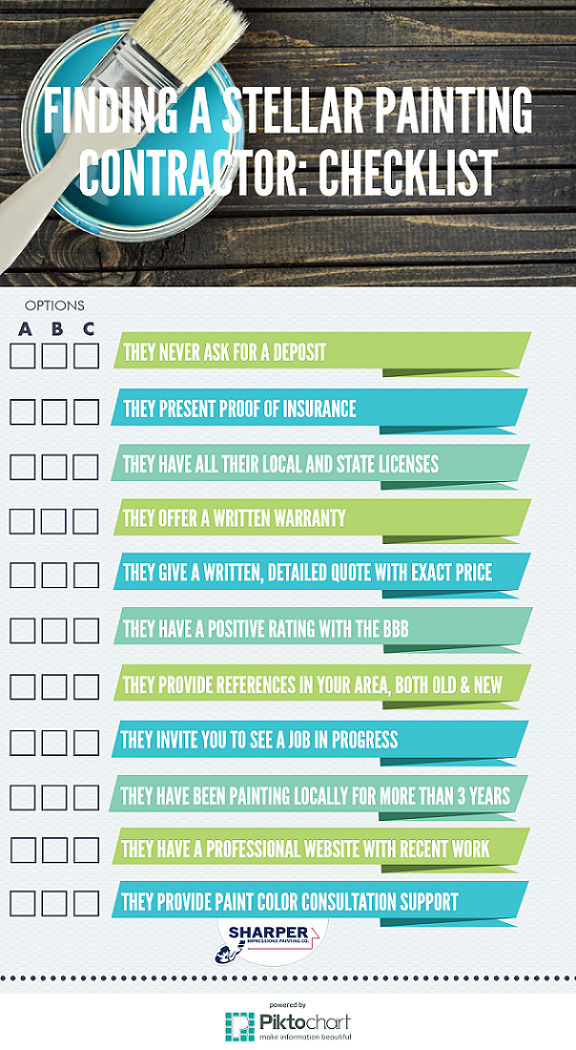Step-By-Step Inside Painting Tips For An Expert Complete
Step-By-Step Inside Painting Tips For An Expert Complete
Blog Article
Authored By-Pehrson Duran
When it comes to accomplishing a professional finish with your indoor painting project, focus to detail is vital. From selecting the ideal paint and devices to performing the paint procedure meticulously, each action plays a vital duty in the last outcome. Nonetheless, there is one aspect typically forgot yet essential for a perfect coating-- the relevance of appropriate ventilation during the paint process. This often ignored element can dramatically influence the general quality of your paint job. Interested to know even more about how air flow can boost your painting results?
Selecting the Right Paint and Equipment
Wondering which repaint and devices are best for your indoor painting job? When it concerns choosing the ideal paint, consider elements like the sort of surface area you're painting, the wanted finish, and the shade choices offered. For walls, a latex paint is usually the most effective selection because of its sturdiness, very easy clean-up, and quick drying time. If you're painting a high-traffic location like a hallway or cooking area, a semi-gloss or satin coating might be preferable as they're simpler to clean up.
As for tools, purchasing high-quality brushes and rollers can make a considerable distinction in the final end result of your paint task. Search for brushes with dense bristles that are suitable for the sort of paint you're utilizing. Roller covers come in various nap sizes, with much shorter snoozes being optimal for smooth surface areas like walls and ceilings, while longer naps are much better for distinctive surface areas.
Readying Your Space for Painting
To make sure a successful indoor painting project, proper preparation of your room is essential. Beginning by getting rid of furnishings from the area or moving it to the center and covering it with plastic sheets. Next, remove any kind of decors, change plates, and outlet covers. Usage painter's tape to protect baseboards, trim, and any kind of areas you do not wish to paint. Load openings and cracks in the wall surfaces with spackling substance, then sand them smooth when dry. Dust and tidy the walls to make certain correct paint adhesion.
After preparing the walls, set ground cloth to protect your floorings. If you're painting the ceiling, cover the entire flooring area with drop cloths, protecting them in place with painter's tape. Ensure https://housepaintersnearme55543.blog-a-story.com/14724560/get-professional-referrals-for-choosing-the-appropriate-color-pattern-and-techniques-to-attain-a-refined-coating-change-your-home-s-style-with-the-assistance-of-specialist-painters by opening up home windows or making use of followers to assist with drying and to lessen the fumes. Lastly, collect all your painting products in one area to have whatever you require within reach. Putting in the time to prepare your room will certainly make the painting procedure smoother and assist you accomplish a professional surface.
Carrying Out the Painting Refine
Begin by selecting the suitable paint color and coating for the room you're painting. Think about the state of mind you want to produce and exactly how natural light influences the shade throughout the day. Once you have your paint, collect top quality brushes, rollers, painter's tape, and drop cloths. Prior to starting, guarantee the wall surfaces are clean and dry.
Beginning by cutting in the sides of the wall surfaces and around trim with a brush. Then, utilize a roller to cover larger areas, working in tiny areas. Bear in mind to keep a damp edge to stop visible lap marks. Use a second layer for a specialist finish, if required.
When paint doors and trim, make use of a smaller brush for precision. Job methodically, using slim, also coats. Get https://www.homesandgardens.com/interior-design/how-to-paint-a-stairwell of the painter's tape while the paint is still somewhat damp to avoid peeling.
Permit the paint to completely dry completely before moving furniture back into location. Take your time and take note of detail for a flawless coating that will transform the appearance of your room.
Final thought
Since you have actually complied with these detailed tips for repainting your inside, you're well on your method to accomplishing a specialist surface.
By choosing the right paint and tools, preparing your area properly, and performing the paint process with care, you can change your home right into a beautifully painted room.
Keep in mind to take your time and appreciate the procedure for the best results. Delighted paint!
